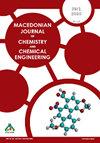Optimization of electro-Fenton oxidation of carbonated soft drink industry wastewater using response surface methodology
IF 0.6
4区 化学
Q3 CHEMISTRY, MULTIDISCIPLINARY
Macedonian Journal of Chemistry and Chemical Engineering
Pub Date : 2020-10-27
DOI:10.20450/mjcce.2020.2101
引用次数: 2
Abstract
The immense volume of highly polluted organic wastewater continuously generated in the beverage industry urges the design of new types of wastewater treatment plants. This study aimed to evaluate the applicability of the electro-Fenton (EF) technique to reduce organic pollution of real effluent from a carbonated soft drink factory. The impact of various process variables like pH, time, current density, H 2 O 2 /Fe 2+ molar ratio, and the volume ratio of H 2 O 2 /soft drink wastewater (SDW) was analyzed using response surface methodology (RSM). The observed responses were in good agreement with predicted values obtained through optimization. The optimum conditions showed a chemical oxygen demand (COD) removal efficiency of 73.07 %, pH of 4.14, time of 41.55 min, current density of 46.12 mA/cm 2 , H 2 O 2 /Fe 2+ molar ratio of 0.9802, and H 2 O 2 /SDW volume fraction of 2.74 ml/l. The EF process was able to effectively diminish the organic pollution, reduce the residence time and, therefore, the operating costs.响应面法优化电Fenton氧化碳酸饮料工业废水
饮料行业不断产生的大量高污染有机废水促使人们设计新型的污水处理厂。本研究旨在评估电芬顿(EF)技术在减少碳酸软饮料厂实际废水有机污染方面的适用性。采用响应面法(RSM)分析了pH、时间、电流密度、H2 O2/Fe2+摩尔比和H2 O2/软饮料废水体积比等工艺变量对SDW的影响。观察到的响应与通过优化获得的预测值非常一致。最佳工艺条件为:化学需氧量(COD)去除率为73.07%,pH为4.14,时间为41.55min,电流密度为46.12mA/cm2,H2 O2/Fe2+摩尔比为0.9802,H2 O2/SDW体积分数为2.74ml/l。EF工艺能够有效地减少有机污染,减少停留时间,从而降低运营成本。
本文章由计算机程序翻译,如有差异,请以英文原文为准。
求助全文
约1分钟内获得全文
求助全文
来源期刊
CiteScore
1.60
自引率
20.00%
发文量
14
审稿时长
>12 weeks
期刊介绍:
Macedonian Journal of Chemistry and Chemical Engineering (Maced. J. Chem. Chem. Eng.) is an official publication of the Society of Chemists and Technologists of Macedonia. It is a not-for-profit open acess journal published twice a year. The journal publishes original scientific papers, short communications, reviews and educational papers from all fields of chemistry, chemical engineering, food technology, biotechnology and material sciences, metallurgy and related fields. The papers published in the Journal are summarized in Chemical Abstracts.

 求助内容:
求助内容: 应助结果提醒方式:
应助结果提醒方式:


